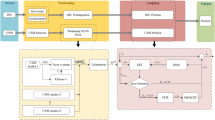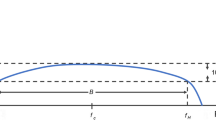Abstract
In this paper, the node localization methods of ZigBee wireless sensor networks were studied. There are two key issues affecting the positioning accuracy: accuracy of RSSI value and optimization of localization algorithm. For the first issue, the effects of two kinds of environmental disturbance on RSSI values were analyzed, and then RSSI values were pretreated using Kalman filter. For the second, the RSSI-based localization algorithm were introduced in detail, and a new algorithm-triangle centroid localization algorithm based on weighted feature points-was proposed. MATLAB simulation and actual network tests were carried out. The simulation and experimental results all showed that our pretreatment strategy of RSSI and optimization of localization algorithm had great effects on positioning accuracy.



















Similar content being viewed by others
References
Wang, R.-C., & Sun, L.-J. (2012). Introduction of wireless sensor network technology. Beijing: Tsinghua University Press.
Hong-Quan, P. U., Jun-Ying, J. I. A., Zhang, X.-J., & Sun, J.-W. (2013). A survey on ZigBee network technology research. Computer Systems and Applications, 9, 6–11.
Kwon, Y., & Agha, G. (2008). Passive localization: Large size sensor network localization based on environmental events. In Proc of ACM/IEEE ISPN (pp. 3–14). ACM.
Miao, C., Dai, G., Ying, K., & Chen, Q. (2015). Collaborative localization and location verification in WSNs. Sensors (Basel), 15(5), 10631–10649.
Yang, Z., & Liu, Y. (2008). Quality of trilateration: Confidence-based iterative localization. In Proc of IEEE ICDCS (pp. 446–453). IEEE.
Jung-Kyu, L., Kim, Y., Jong-Ho, L., & Seong-Cheol, K. (2014). An efficient three-dimensional localization scheme using trilateration in wireless sensor networks. IEEE Communications Letters, 18(9), 1591–1594.
Wang, P. (2013). A RSSI based locating algorithm for multi-robot system. State University of New York at Stony Brook: Dissertations & Theses, Gradworks.
Wang, P., Li, Y., Chen, X., & Li, J. (2014). WSNs localization algorithm based on RSSI distance correction. Sensors and Micro Systems, 5(135–137), 140.
Mao, B. X., Liu, S., & Chai, J. P. (2014). Research on indoor 3D location technology based on RSSI. Applied Mechanics and Materials, 696, 241–246.
Lin, W., & Chen, C. (2009). Triangle centroid localization algorithm for wireless sensor networks based on RSSI. Modern Electronic Technology, 2, 179–181.
Guo, R., & Ma, Y. (2014). Optimization strategy of triangle centroid location algorithm based on RSSI. Microelectronics and Computer, 3, 111–114.
Wang, X. (2013). Microwave technology and antenna (3rd ed.). Beijing: Electronic Industry Press.
Wen, J. (2014). Research on the localization technology in wireless sensor network under complex conditions. Nanjing: Nanjing University of Aeronautics and Astronautics.
Jianbo, F. U. (2007). Research on the three-dimensional range-free localization algorithm For WSN. Changsha: Central South University.
Liu, Y., Jin, M., & Cui, C. (2010). Modified weighted centroid localization algorithm for wireless sensor networks based on RSSI. Journal of Sensing Technology, 23(5), 717–720.
Xu, Z., Zhang, H., Hu, C., Mei, L., Xuan, J., Choo, K.-K. R., et al. (2016). Building knowledge base of urban emergency events based on crowdsourcing of social media. Concurrency and Computation: Practice and Experience, 28(15), 4038–4052.
Xu, Z., Zhang, H., Sugumaran, V., Choo, K.-K. R., Mei, L., & Zhu, Y. (2016). Participatory sensing-based semantic and spatial analysis of urban emergency events using mobile social media. EURASIP Journal on Wireless Communications and Networking, 2016(1), 1–9.
Xu, Z., Luo, X., & Wang, L. (2011). Incremental building association link network. Computer Systems Science and Engineering, 26(3), 153–162.
Zheng, Xu, et al. (2015). Knowle: A semantic link network based system for organizing large scale online news events. Future Generation Computer Systems, 43–44, 40–50.
Xu, Z., et al. The mobile media based emergency management of web events influence in cyber-physical space. Wireless Personal Communications. doi:10.1007/s11277-016-3689-7.
Acknowledgements
The authors would like to thank the Natural Science Foundation Program of Inner Mongolia (2015MS0632) and the Inner Mongolia Autonomous Region Science and Technology Plan Project (20140712) for financial support.
Author information
Authors and Affiliations
Corresponding author
Rights and permissions
About this article
Cite this article
Yu, Zz., Guo, Gz. Improvement of Positioning Technology Based on RSSI in ZigBee Networks. Wireless Pers Commun 95, 1943–1962 (2017). https://doi.org/10.1007/s11277-016-3860-1
Published:
Issue Date:
DOI: https://doi.org/10.1007/s11277-016-3860-1




